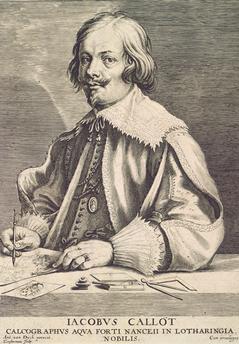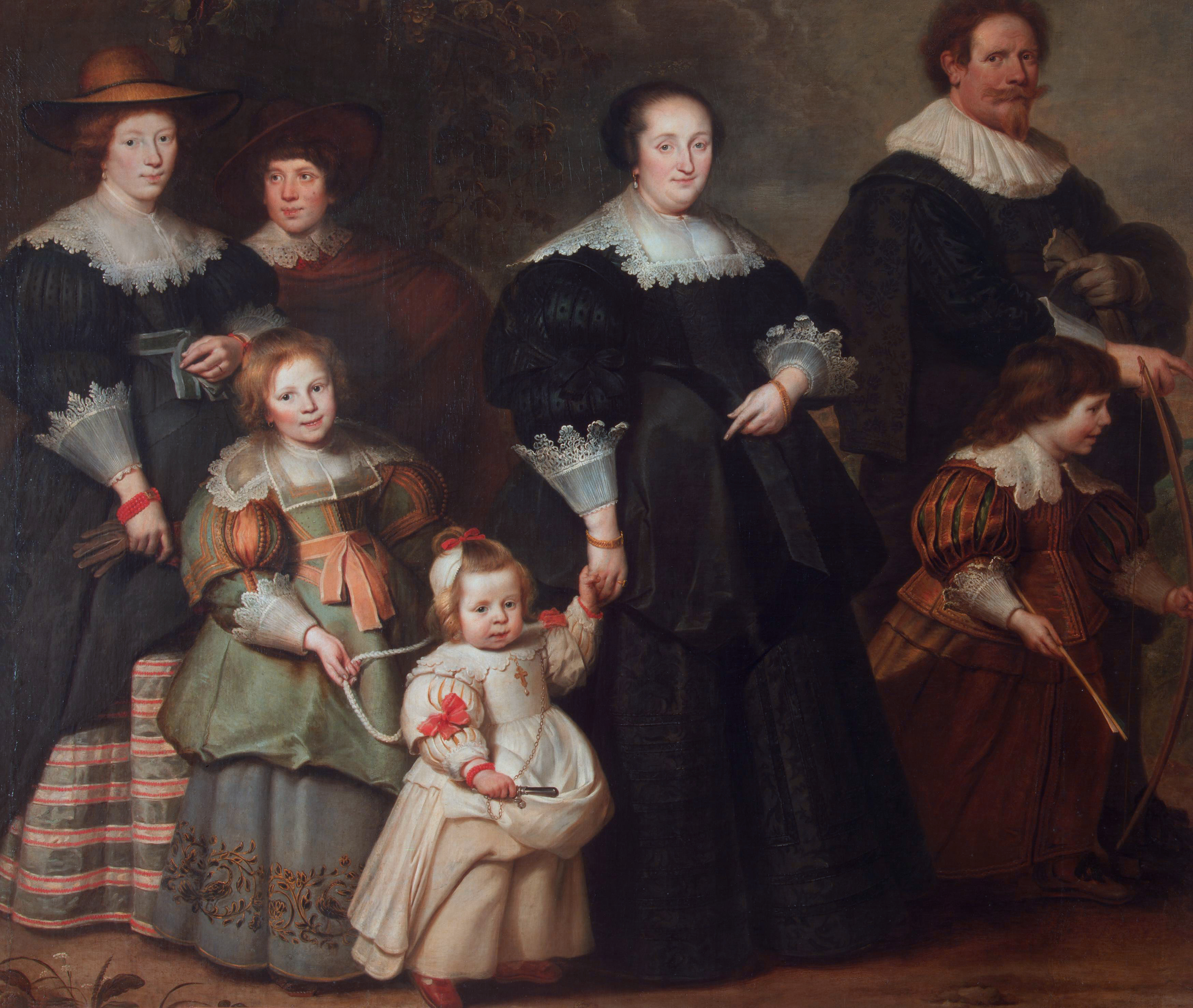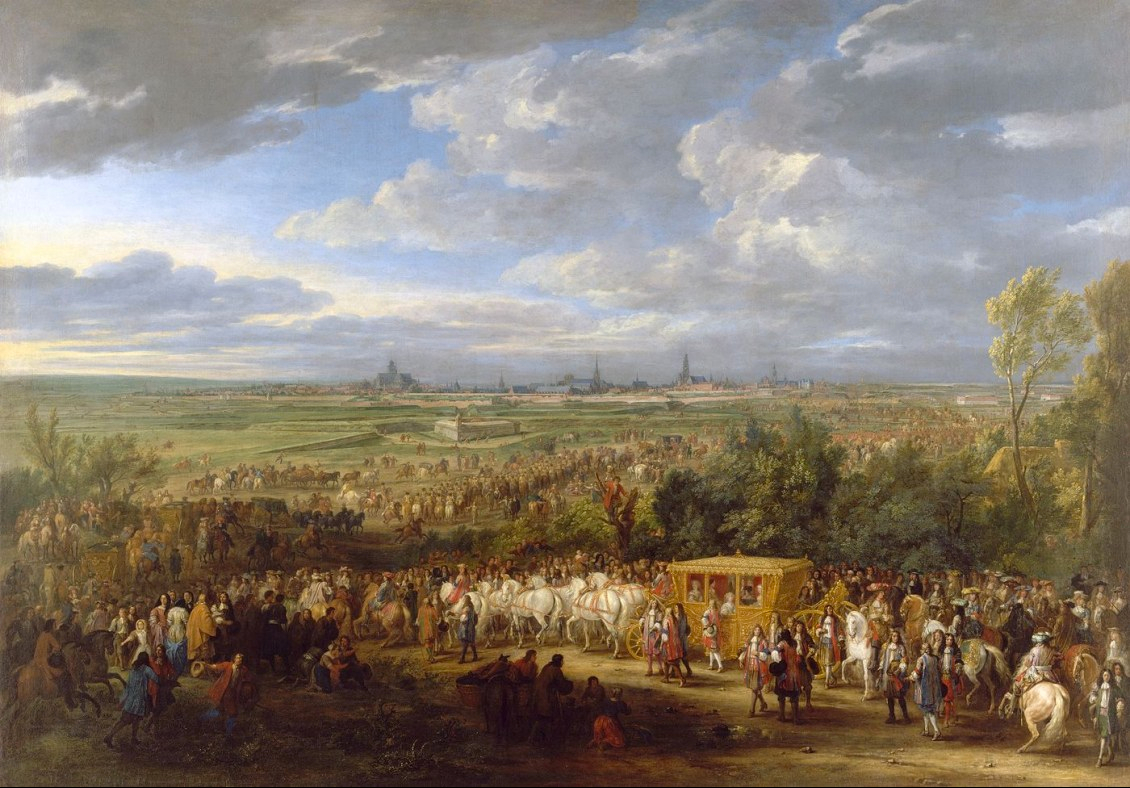|
Nicolas Cochin
Nicolas Cochin (1610–1686), called the Elder, was a French draughtsman and engraver. He was born at Troyes in 1610, the son of a painter named Noel Cochin. About 1635, he went to Paris, where he died in 1686. He often imitated and copied Jacques Callot, but chose for his model Stefano della Bella, some of whose drawings he engraved. Like these two artists he excelled in small figures, which he grouped and delineated with lifelike animation. His specialty was topography, including battles, sieges, and encampments. He engraved several hundred subjects, the most important of which are those he executed for the "Glorieuses Conquêtes de Louis le Grand", called the "Grand Beaulieu", published between 1676 and 1694. The best of these plates may be the "Siege of Arras", engraved on 16 plates by Cochin and Jean Frosne. Cochin is the best of the engravers whom Troyes has produced. His drawing is firm, and his engraving fine and delicate. His plates are marked with his name in full, or wit ... [...More Info...] [...Related Items...] OR: [Wikipedia] [Google] [Baidu] |
Troyes
Troyes () is a commune and the capital of the department of Aube in the Grand Est region of north-central France. It is located on the Seine river about south-east of Paris. Troyes is situated within the Champagne wine region and is near to the Orient Forest Regional Natural Park. Troyes had a population of 61,996 inhabitants in 2018. It is the center of the agglomeration community Troyes Champagne Métropole, which was home to 170,145 inhabitants. Troyes developed as early as the Roman era, when it was known as Augustobona Tricassium. It stood at the hub of numerous highways, primarily the Via Agrippa. The city has a rich historical past, from the Tricasses tribe to the liberation of the city on 25 August 1944 during the Second World War, including the Battle of the Catalaunian Plains, the Council of Troyes, the marriage of Henry V and Catherine of France, and the Champagne fairs to which merchants came from all over Christendom. The city has a rich architectural ... [...More Info...] [...Related Items...] OR: [Wikipedia] [Google] [Baidu] |
Jacques Callot
Jacques Callot (; – 1635) was a baroque printmaker and draftsman from the Duchy of Lorraine (an independent state on the north-eastern border of France, southwestern border of Germany and overlapping the southern Netherlands). He is an important person in the development of the old master print. He made more than 1,400 etchings that chronicled the life of his period, featuring soldiers, clowns, drunkards, Gypsies, beggars, as well as court life. He also etched many religious and military images, and many prints featured extensive landscapes in their background. Life and training Callot was born and died in Nancy, the capital of Lorraine, now in France. He came from an important family (his father was master of ceremonies at the court of the Duke), and he often describes himself as having noble status in the inscriptions to his prints. At the age of fifteen he was apprenticed to a goldsmith, but soon afterward travelled to Rome where he learned engraving from an expatri ... [...More Info...] [...Related Items...] OR: [Wikipedia] [Google] [Baidu] |
Stefano Della Bella
Stefano della Bella (17 May 1610 – 12 July 1664) was an Italian draughtsman and printmaker known for etchings of a great variety of subjects, including military and court scenes, landscapes, and lively genre scenes. He left 1052 prints, and several thousand drawings, but only one known painting. He was born and died in Florence, Italy. Early life in Florence Della Bella was born at Florence to a family of artists, and was apprenticed to a goldsmith,Chishholm 1911. but became an engraver working briefly under Orazio Vanni and then Cesare Dandini.Massar 1996. He studied etching under Remigio Cantagallina, who had also been the instructor of Jacques Callot.Massar 1968, p. 160. Della Bella's early prints are very similar to those of Callot. When he was seventeen years of age, he presented an etching depicting a banquet in the Palazzo Pitti to the young Giancarlo de' Medici following which della Bella would receive official commissions by the Medici family. In 1630, at the age of ... [...More Info...] [...Related Items...] OR: [Wikipedia] [Google] [Baidu] |
Jean Frosne
Jean may refer to: People * Jean (female given name) * Jean (male given name) * Jean (surname) Fictional characters * Jean Grey, a Marvel Comics character * Jean Valjean, fictional character in novel ''Les Misérables'' and its adaptations * Jean Pierre Polnareff, a fictional character from ''JoJo's Bizarre Adventure'' Places * Jean, Nevada, USA; a town * Jean, Oregon, USA Entertainment * Jean (dog), a female collie in silent films * "Jean" (song) (1969), by Rod McKuen, also recorded by Oliver * ''Jean Seberg'' (musical), a 1983 musical by Marvin Hamlisch Other uses * JEAN (programming language) * USS ''Jean'' (ID-1308), American cargo ship c. 1918 * Sternwheeler Jean, a 1938 paddleboat of the Willamette River See also *Jehan * * Gene (other) * Jeanne (other) * Jehanne (other) * Jeans (other) * John (other) John is a common English name and surname: * John (given name) * John (surname) John may also refer to: New ... [...More Info...] [...Related Items...] OR: [Wikipedia] [Google] [Baidu] |
Albrecht Dürer
Albrecht Dürer (; ; hu, Ajtósi Adalbert; 21 May 1471 – 6 April 1528),Müller, Peter O. (1993) ''Substantiv-Derivation in Den Schriften Albrecht Dürers'', Walter de Gruyter. . sometimes spelled in English as Durer (without an umlaut) or Duerer, was a German painter, printmaker, and theorist of the German Renaissance The German Renaissance, part of the Northern Renaissance, was a cultural and artistic movement that spread among Germany, German thinkers in the 15th and 16th centuries, which developed from the Italian Renaissance. Many areas of the arts and .... Born in Free Imperial City of Nuremberg, Nuremberg, Dürer established his reputation and influence across Europe in his twenties due to his high-quality List of woodcuts by Dürer, woodcut prints. He was in contact with the major Italian artists of his time, including Raphael, Giovanni Bellini, and Leonardo da Vinci, and from 1512 was patronized by Holy Roman Emperor, Emperor Maximilian I, Holy Roman Emperor, Ma ... [...More Info...] [...Related Items...] OR: [Wikipedia] [Google] [Baidu] |
Paolo Veronese
Paolo Caliari (152819 April 1588), known as Paolo Veronese ( , also , ), was an Italian Renaissance painter based in Venice, known for extremely large history paintings of religion and mythology, such as ''The Wedding at Cana'' (1563) and ''The Feast in the House of Levi'' (1573). Included with Titian, a generation older, and Tintoretto, a decade senior, Veronese is one of the "great trio that dominated Venetian painting of the '' cinquecento''" and the Late Renaissance in the 16th century.Rosand, 107 Known as a supreme colorist, and after an early period with Mannerism, Paolo Veronese developed a naturalist style of painting, influenced by Titian. His most famous works are elaborate narrative cycles, executed in a dramatic and colorful style, full of majestic architectural settings and glittering pageantry. His large paintings of biblical feasts, crowded with figures, painted for the refectories of monasteries in Venice and Verona are especially famous, and he was also the ... [...More Info...] [...Related Items...] OR: [Wikipedia] [Google] [Baidu] |
Cornelis De Vos
Cornelis de Vos (1584 – 9 May 1651) was a Flemish painter, draughtsman and art dealer. He was one of the leading portrait painters in Antwerp and is best known for his sensitive portraits, in particular of children and families. He was also successful in other genres including history, religious and genre painting. He was a regular collaborator with Rubens. Life He was born in Hulst near Antwerp, now in the Dutch province of Zeeland. Little is known of his childhood. His father moved with his family to Antwerp in 1596. Cornelis and his younger brothers Paul and Jan (or Hans) studied under the little-known painter David Remeeus (1559–1626). In 1599 de Vos is mentioned as Remeeus' pupil while on 8 May 1604 he is referred to as the chief assistant of Remeeus.Cornelis de Vos at the |
Charles Audran
Charles Audran (1594–1674) was a French engraver. Life Charles Audran was the first of the Audran family who became eminent in the art of engraving. He was born in Paris in 1594. In his boyhood he showed a great disposition for the art. He received some instruction in drawing, and when still young went to Rome to complete his studies. There he produced some plates that were admired. He adopted that species of engraving that is entirely performed with the graver, and seems to have modeled his style on that of Cornelis Bloemaert. On his return to France he lived for some time in Lyons, but finally settled in Paris, where he died in 1674, aged 80. He marked his prints, which are very numerous, in the early part of his life with a "C-", until his brother Claude, who also engraved a few plates, marked them with the same letter; he then changed it for K., as the initial of Karl. The following are his principal prints : Portraits *'' Henri of Condé, with the Four Cardinal Vir ... [...More Info...] [...Related Items...] OR: [Wikipedia] [Google] [Baidu] |
Adam Frans Van Der Meulen
Adam Frans van der Meulen or Adam-François van der MeulenAdam Frans van der Meulen at the (11 January 163215 October 1690) was a Flemish painter and draughtsman who was particularly known for his scenes of military campaigns and conquests.Christine van Mulders. "Meulen, Adam Frans van der." Grove Art Online. Oxford Art Online. Oxford University Press. Web. 4 September 2017 Van der Meulen also painted portraits, hunting scenes, paintings of chateaux and landscapes. He created designs for prints and |
1610 Births
Year 161 ( CLXI) was a common year starting on Wednesday (link will display the full calendar) of the Julian calendar. At the time, it was known as the Year of the Consulship of Caesar and Aurelius (or, less frequently, year 914 ''Ab urbe condita''). The denomination 161 for this year has been used since the early medieval period, when the Anno Domini calendar era became the prevalent method in Europe for naming years. Events By place Roman Empire * March 7 – Emperor Antoninus Pius dies, and is succeeded by Marcus Aurelius, who shares imperial power with Lucius Verus, although Marcus retains the title Pontifex Maximus. * Marcus Aurelius, a Spaniard like Trajan and Hadrian, is a stoical disciple of Epictetus, and an energetic man of action. He pursues the policy of his predecessor and maintains good relations with the Senate. As a legislator, he endeavors to create new principles of morality and humanity, particularly favoring women and slaves. * Aurelius ... [...More Info...] [...Related Items...] OR: [Wikipedia] [Google] [Baidu] |
1686 Deaths
Events January–March * January 3 – In Madras (now Chennai) in India, local residents employed by the East India Company threaten to boycott their jobs after corporate administrator William Gyfford imposes a house tax on residences within the city walls. Gyfford places security forces at all entrances to the city and threatens to banish anyone who fails to pay their taxes, as well as to confiscate the goods of merchants who refuse to make sales. A compromise is reached the next day on the amount of the taxes. * January 17 – King Louis XIV of France reports the success of the Edict of Fontainebleau, issued on October 22 against the Protestant Huguenots, and reports that after less than three months, the vast majority of the Huguenot population had left the country. * January 29 – In Guatemala, Spanish Army Captain Melchor Rodríguez Mazariegos leads a campaign to conquer the indigenous Maya people in the rain forests of Lacandona, departing ... [...More Info...] [...Related Items...] OR: [Wikipedia] [Google] [Baidu] |
People From Troyes
A person ( : people) is a being that has certain capacities or attributes such as reason, morality, consciousness or self-consciousness, and being a part of a culturally established form of social relations such as kinship, ownership of property, or legal responsibility. The defining features of personhood and, consequently, what makes a person count as a person, differ widely among cultures and contexts. In addition to the question of personhood, of what makes a being count as a person to begin with, there are further questions about personal identity and self: both about what makes any particular person that particular person instead of another, and about what makes a person at one time the same person as they were or will be at another time despite any intervening changes. The plural form "people" is often used to refer to an entire nation or ethnic group (as in "a people"), and this was the original meaning of the word; it subsequently acquired its use as a plural form of p ... [...More Info...] [...Related Items...] OR: [Wikipedia] [Google] [Baidu] |








_1938.jpg)